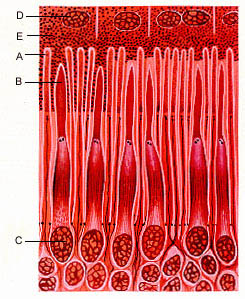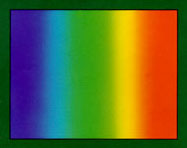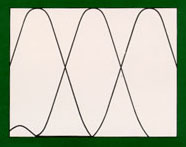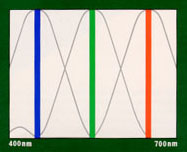The Functioning Principle of The Visual Organ
Photoreceptor Cells
On the eye's retina there are tiny little photoreceptor cells (15.000 / per sq. mm) called cones and rods. A current hypothesis suggests that the only function of the rods is to see variations of light intensity. In contrast, Kueppers is of the opinion that the function of the rods is controlling the mechanisms of adaptation and correction of the visual organ. There exist three different types of cones, which are sensitive to different spectral regions. One type reacts to the short-wave region of the spectrum, the other to the medium-wave and the third one to the long-wave regions, respectively. These photoreceptor cells on the retina are quantal collectors. Each type of cone traps the wavelengths it is sensitive to. Quanta are minuscule bits of energy, i.e. electric data.
Light rays are carriers of data concerning the nature and appearance of the " outside world ".

Cross section of the retina: rods (A), cones (B), cell nuclei of cone cells (C). Light passes first through the pigment epithelium (E) where the cell nuclei (D) are embedded.
The Code
For every image spot on the retina the existing three types of cones produce a organ-intrinsic three-part electric code. This code starts to develop once the adaptation and correction processes of the visual organ are completed. It consists of three values, one value each for the cone types sensitive to short-wave, medium-wave, and long-wave radiation, respectively.
Again, concerning the function of the cones there exist various hypotheses. In colorimetry currently the Compensation Color Theory is prevailing on which the CIE-Lab system is based. The results of Kueppers' research prove that this theory does not offer an explanation concerning the functioning principle of the visual organ or the color mixing laws deriving from it. For this reason, that theory is unable to provide any valid teaching contribution to understand the connections between the physical, physiological, and psychological circumstances of seeing.
Due to the adaptation and correction processes of the visual organ no firm correlation exists between color stimulus and color sensation. This firm correlation is generated between code and color sensation.

Equi-energy spectrum of direct sunlight

Sensitivity regions of the 3 cone types

Color perception attributed to the cone types
The Three Fundamental Colors
The three-part data record of the code for every image spot on the retina is sent through the nerve tracts to the brain. Strictly speaking, at this time the Code is not yet a color but rather an electric signal. But it depends on this code which color sensation will be generated in the brain of the observer, that is which color shade he will perceive.
For didactical reasons, this aspect is explained in Kueppers' Theory of Color as follows: A sensory force is assigned to each type of cone, called Fundamental Color (FuCo). The Fundamental Color Violet-blue(FuCo B) is attributed to the cone reacting to short-wave radiation, as if only this cone type reacts the color sensation Violet-blue is generated. If only medium-wave radiation exists the visual organ responds with the color sensation Green. Therefore we call this Fundamental Color Green (FuCo G). And finally long-wave radiation stimulating only the appropriate cone type produces the color sensation Orange-red, i.e. the Fundamental Color Orange-red (FuCo R).
The sensory forces of the visual organ attributed to the three types of cones are defined as Fundamental Colors. We call them FuCo "R", FuCo "G", and FuCo "B".

Color perception attributed to the three cone types
The Eight Basic Colors
The fact that there exist different types of cones on the retina of the human eye which are sensitive to different spectral regions (see: Fundamental Colors) is currently a worldwide recognized scientific finding. However, from this reality Kueppers draws different, i.e. new conclusions : If these three sensory forces are active in the visual organ the logical conclusion is that eight extreme color sensations are possible. Kueppers calls these maximum eight color sensations Basic Colors (BaCo). They result in the following way :
| Fundamental Colors | Basic Colors | |
| No FuCo | = BaCo K |  |
| FuCo B | = BaCo B |  |
| FuCo G | = BaCo G |  |
| FuCo R | = BaCo R |  |
| FuCo B + FuCo G | = BaCo C |  |
| FuCo B + FuCo R | = BaCo M |  |
| FuCo G + FuCo R | = BaCo Y |  |
| FuCo B + FuCo G + FuCo R | = BaCo W |  |
In Kueppers' Theory of Color the eight Basic Colors have the following designation : Black (K) ; Violet-blue (B) ; Green (G) ; Orange-red (R) ; Cyan-blue (C) ; Magenta-red (M) ; Yellow (Y) ; White (W).
The eight extreme possibilities of visual sensation are called Basic Colors, being : BaCo K ; BaCo B ; BaCo G ; BaCo R ; BaCo C ; BaCo M ; BaCo Y ; BaCo W.
Problem of Color Names
An observer with normal sight is able to distinguish between 100.000 and 1 million color shades. According to its level of education every person disposes of a vocabulary from 2000 to 6000 words. In principle, every distinguishable color shade is a different color. This demonstrates that it is totally impossible to give color shades precise names. In consequence, it is not surprising that the few names used in colloquial language are not indicating precisely defined colors. Their names rather cover great color areas. Red cabbage is red. Red hair is red, too. And a person turns red when the blood rushes to its head. A lemon is yellow and the yellow of an egg is yellow as well. The sky is blue and also the suit of a flight captain is blue.
But there exists still another problem. In certain professional sectors and also in literature the same color names are used for quite different Basic Colors. Some sectors think of Magenta-red when saying red or Cyan-blue when saying blue, e.g.: artists and art teachers, printers and house painters and many authors. In contrast, physicians, colorimetrists and computer experts mean Orange-red when saying red and Violet-blue when saying blue. This is a linguistic dilemma as there exist two red and two blue Basic Colors. And obviously, it is impossible to change the colloquial language as much as it seems to be impossible to alter habits in the different professional sectors.
If we regard the Theory of Color as a science we must use specialist terms as in all the other sciences in order to express ourselves clearly and unequivocally. The computer industry will continue to use the worldwide introduced and accepted abbreviation RGB for Red (Orange-red), Green and Blue (Violet-blue). To be able to explain and understand the scientific contexts of the Theory of Color we have to learn to think differently or to indicate the proper names of Fundamental Colors and Basic Colors in parentheses as memory aid.
Other terms
| Term | Definition |
| Primary Color | The term Primary Color defines the initial colors used in a process. In a Subtractive Mixture (SubMi) it relates to the chromatic Basic Colors Y, M, and C plus the achromatic Key Color White (W). In an Additive Mixture (AddMi) it relates to the chromatic Basic Colors R, G, and B plus the achromatic Key Color Black (K). In an Integrated Mixture (IntMi) the term is used for all 8 Basic Colors. |
| Secondary Color | This term applies to the mixture of two Primary Colors. |
| Tertiary Color | This term applies to the mixture of three Primary Colors. |
| Key Color | Refers only to the achromatic background colors White (W) and Black (K) in specific contexts |
In the Theory of Color we have to learn the names and terms of colors like the vocabulary of a foreign language.
back to top
 Functioning Principle of Vision
Functioning Principle of Vision Color Mixing Laws
Color Mixing Laws Color and Printing Process
Color and Printing Process Theory of Color
Theory of Color Teaching Material and Literature
Teaching Material and Literature